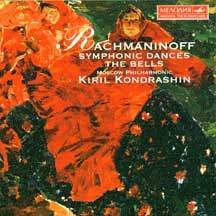| All Artists: Rachmaninoff, Rozhdestvensky Title: Rachmaninoff: Symphonic Dances/The Bells Members Wishing: 0 Total Copies: 0 Label: RCA Release Date: 3/26/1996 Genres: Dance & Electronic, Classical Styles: Opera & Classical Vocal, Historical Periods, Modern, 20th, & 21st Century, Symphonies Number of Discs: 1 SwapaCD Credits: 1 UPC: 743213204628 |
Search - Rachmaninoff, Rozhdestvensky :: Rachmaninoff: Symphonic Dances/The Bells
 | Rachmaninoff, Rozhdestvensky Rachmaninoff: Symphonic Dances/The Bells Genres: Dance & Electronic, Classical
|
Larger Image |
CD Details |
CD ReviewsThe most convincing Symphonic Dances on CD Anonymous | California USA | 05/08/1999 (5 out of 5 stars) "If you want to understand Rachmaninov's last masterpiece -- the Symphonic Dances -- you must listen to this CD. Kondrashin brings out the latent emotional power of the Dances in a way no-one else does. Others, for example Ashkenzy, play this music as a mere orchestral display piece. Kondrashin makes it heard-rending.The Bells is also an excellent performance, but here the weird Soviet engineering (fully acceptable in the Dances) is more of a problem, with its spotlight on solo singers, and problems with the loudest passages. But this CD is essential in any Rachmaninov collection." Hold On To Your Mind Michael Newberry | Santa Monica | 07/27/2000 (5 out of 5 stars) "This Symphonic Dances, for me, is the best version hands down! And that "hands down" is delivered with a thunderous slam on the table. Kondrashin's conducting is deliciously wild, erotic, pathetic, glorious, cataclysmic, and catastrophic. He keeps a Toscanini-like command of the structure of the whole piece. He weaves in and out of big phrases, being tender one moment and aggressively stretching the limits of the music in other parts, and throughout the hauntingly gorgeous melodies are inflicted onto us. In the last minutes of the piece the music builds up so much passion, tension, and raw energy, becomes so orgasmic, that the sweep absolutely obliterates understanding, and the whole concept crashes into chaos.The Previn and Ashkenazy versions are anemic by comparison. The sound is quite good for a '63 recording, and the included Bells is equally great except for the disappointing soprano." Spectacular, thrilling...Noisey! vmzfla | Orlando, Fl. | 08/06/2007 (3 out of 5 stars) "No one can doubt the true Russian authority of these early 1960s performances by Kondrashin and the Moscow Philharmonic. Judging by the high Amazon prices, it is surely a rare collectors item. Beware before buying that BMG decidedly through enhanced remastering, attempts to bill it as a sonic-blockbuster. To Rachmaninov's credit, he took the romanticism of the 19th century and powerfully launches it into the 20th century. Rachmaninov's last work, "Symphonic Dances"(1940)is actually a consumation of quotations from some of his other important compositions. The recording though vivid suffers from shrillness and is uneven in detail and balance throughout but is most evident in the 3rd. movement finale. "The Bells"(1913) a choral symphony with words by Edgar Allan Poe, does not do much better. Orchestra and soloists are projected forward, so the sound ends up in your lap! The composer takes the listener through an ingenious musical romp from cradle to grave. Each movement relying on a different kind of bell, ie. silver, gold etc. The last movement is most subdued, depicting the feel of heavenly ascension after death. This is not a bad recording, but a more subtle digital remastering process would have been a benefit. The historic value of keeping Kiril Kondrashin in the catalogue may warrant an additional star."
|

 Track Listings (7) - Disc #1
Track Listings (7) - Disc #1